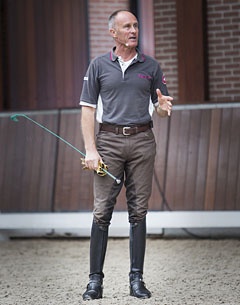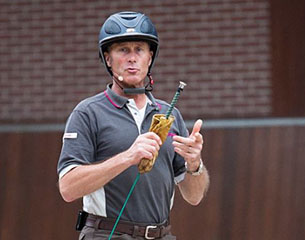
In Rien van der Schaft’s previous article, he spoke about the phase most riders forget about, the phase of the contact rein. In this first phase of the training you want to achieve three things, namely relaxation, forwardness and that your horse accepts the contact. Once you’ve established that, it’s time to move onto the second phase. Rien will explain what this phase looks like and what you should pay attention to.
Rien: “In the second phase of the training, you want to start influencing the balance of your horse. In contrast, in the first phase you let your horse find his natural balance and you more or less don’t care about the frame. You just want your horse to learn to trust your hand and to follow your hand. In the second phase, however, you want to start dividing the weight more equally over your horse’s four legs. You want to go from your horse’s natural balance towards horizontal balance.”
“To be able to achieve this, you can ride movements like shoulder fore, shoulder in, half-pass and transitions. All these movements help stimulate the hind leg to bring itself more under the body so that the front legs become lighter. However, riding these movements can only be of value when you have the right connection.”
“With the right connection I mean that the connection should have the right direction. The direction of the connection should always be forward-downwards. That means when I open my fingers, the horse should want to go forward-down with his head and not upwards. If you horse ‘escapes’ by lifting his head as soon as he gets the freedom to do so, that’s a signal you don’t have the right connection. It’s a signal your horse doesn’t have the right top line.”
“You can only get that forward-down direction when you’ve paid attention to riding your horse with the contact rein, which is the first phase of the training. So that your horse trusts your hand and has learnt to accept and follow your hand. However, it can be very tempting to take, what seems like, a short cut and force a certain head-neck position on your horse. But when you force your horse into a certain frame the connection will most likely have the wrong direction.”
“Once you feel your horse has an urge to take your hand into a forward-down direction, you can start to stimulate the hind legs a bit more with the movements I mentioned, followed by resisting the forward energy a little bit with your hand. This way you can start to change the direction in which your horse is moving. You go from a forward-down direction towards a more horizontal direction and eventually, when collecting your horse, to a more upward direction without losing the correct use of the top line.”
 “But every time you want to make sure you have the right direction of the connection. Check what happens when you open your fingers. Does your horse want to take your hands forward-downwards? Excellent. If not, stop riding that shoulder in or stop riding those transitions and first focus on getting the right connection again. And that’s not by forcing a certain frame, but by riding the body of your horse towards his head, from back to front.”
“But every time you want to make sure you have the right direction of the connection. Check what happens when you open your fingers. Does your horse want to take your hands forward-downwards? Excellent. If not, stop riding that shoulder in or stop riding those transitions and first focus on getting the right connection again. And that’s not by forcing a certain frame, but by riding the body of your horse towards his head, from back to front.”
If you’re unsure whether you have the right fundamentals in place, you can check out this test you can download for free. If you want to go more in depth, check out the online training Rien van der Schaft has created in collaboration with DressagePro in which he teaches the training of dressage horses in four steps.
About Rien van der Schaft
Rien van der Schaft runs a professional dressage yard "Stable Sprengenhorst" with his wife Inge and daughter Romy. As of 2017, Rien has been appointed team trainer of the Dutch National Dressage Team. Rien has trained and competed nine horses up to Grand Prix level and trained many more. He was member of the Dutch team from 1979 till 1983 and competed at the Alternate Olympic Games in Goodwood, two European Championships and one World Championship.
To learn more about the online training, visit http://dressagepro.com/online-program-from-basics-to-grand-prix/
Download the free "Training Fundamentals Online Test"
text by Conny Loonstra - Photos © Jennifer Fotografie